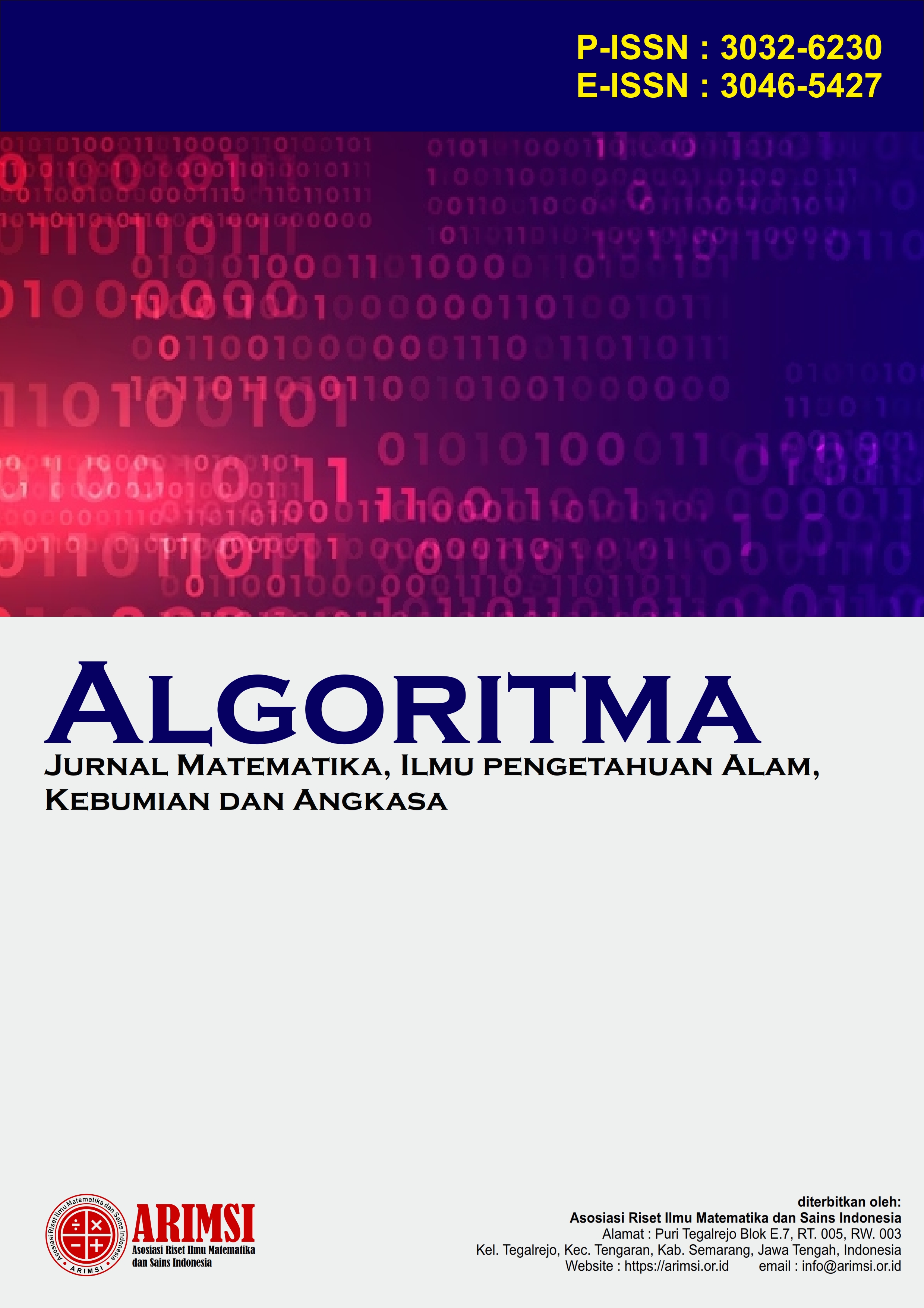Nanopartikel TIO2 Dari Ekstrak Daun Kemangi (Ocimum Sanctum) Untuk Degradasi Metilen Biru
DOI:
https://doi.org/10.62383/algoritma.v2i3.59Keywords:
Green synthesis, Eugenol, Photocatalytic activity, Percent degradationAbstract
The part of the basil plant is the leaves which have various types of benefits if studied further. With the introduction of secondary metabolites, it can be said that basil leaves contain eugenol compounds. The eugenol compound can be used as a reducing agent in the synthesis of TiO2 nanoparticles. The precursor used in the synthesis of TiO2 is titanium isopropoxide which has an oxidation state of +4. By utilizing the green synthesis method, TiO2 was reacted with basil leaf extract and then characterized using XRD and FTIR. The resulting particle size is 10.86 nm. And FTIR shows a wave number of 874.59 which represents the Ti-O functional group. Photocatalytic activity can take advantage of the synthesis of TiO2 nanoparticles by placing the nanoparticles in a methylene blue solution which has a concentration of 20 ppm and varies based on contact time and adsorbent mass. Photocatalytic activity testing obtained a degradation percentage of 79%-84% which varied based on adsorbant mass and contact time. Varying the adsorbant mass and time results in a degradation percentage that increases with each additional mass but will not increase again if it has reached the optimum phase and can reduce the degradation percentage.
Downloads
References
A, N., & Jothivenkatachalam, K. (2014). Visible light assisted TiO2- chitosan composite for removal of reactive dye. Journal of Environmental Nanotechnology, 3(3), 20–26. https://doi.org/10.13074/jent.2014.09.42085
Al-Nuaim, M. A., Alwasiti, A. A., & Shnain, Z. Y. (2023). The photocatalytic process in the treatment of polluted water. Chemical Papers, 77(2), 677–701. https://doi.org/10.1007/s11696-022-02468-7
Andari, N. D., & Wardhani, S. (2014). Fotokatalis TiO2-Zeolit Untuk Degradasi Metilen Biru. Chem. Prog, 7(1), 9–13.
Athikoh, N., Yulianto, E., Kinandana, A. W., Sasmita, E., Sanjani, A. H., Wahyu Mustika, R., Putra Pratama, A., Farida Amalia, N., Gunawan, G., & Nur, M. (2020). Reduction of Methylene Blue by Using Direct Continuous Ozone. Journal of Environment and Earth Science, 10(4), 46–56.
Fajriati, I., Mudasir, Tri Wahyuni, & Endang. (2014). The Influence of Cu(II) on Methyl Orange and Methylene Blue Photodegradation Catalyzed by TiO2 – Chitosan Nanocomposites. International Journal of Advances in Chemical Engineering and Biological Sciences, 1(1), 21–24. https://doi.org/10.15242/IJACEBS.C1113037
Hardeli, A., Ramadhani, D., Kurniawati, N., Andriko, & Sanjaya, H. (2014). Degradasi Methyl Violet Dan Methylen Blue Oleh Fotokatalis TIO2. Jurnal EKSAKTA, 1.
Kaur, M., & Singh, K. (2019). Review on titanium and titanium based alloys as biomaterials for orthopaedic applications. Materials Science and Engineering: C, 102, 844–862. https://doi.org/10.1016/j.msec.2019.04.064
Khan, I., Saeed, K., Zekker, I., Zhang, B., Hendi, A. H., Ahmad, A., Ahmad, S., Zada, N., Ahmad, H., Shah, L. A., Shah, T., & Khan, I. (2022). Review on Methylene Blue: Its Properties, Uses, Toxicity and Photodegradation. Water, 14(2), 242. https://doi.org/10.3390/w14020242
Kumari, H., Sonia, Suman, Ranga, R., Chahal, S., Devi, S., Sharma, S., Kumar, S., Kumar, P., Kumar, S., Kumar, A., & Parmar, R. (2023). A Review on Photocatalysis Used For Wastewater Treatment: Dye Degradation. Water, Air, & Soil Pollution, 234(6), 349. https://doi.org/10.1007/s11270-023-06359-9
Le, A. T., Pung, S. Y., Chiam, S. L., Josoh, N. A. H. B. N., Koay, T. Y., Lee, J. S., & Mustar, N. B. (2020). Photocatalytic performance of TiO2 particles in degradation of various organic dyes under visible and UV light irradiation. 020017. https://doi.org/10.1063/5.0016025
Mondal, S., De Anda Reyes, M. E., & Pal, U. (2017). Plasmon induced enhanced photocatalytic activity of gold loaded hydroxyapatite nanoparticles for methylene blue degradation under visible light. RSC Advances, 7(14), 8633–8645. https://doi.org/10.1039/C6RA28640B
Nair, A. K., Roy George, D., Jos Baby, N., Reji, M., & Joseph, S. (2021). Solar dye degradation using TiO2 nanosheet based nanocomposite floating photocatalyst. Materials Today: Proceedings, 46, 2747–2751. https://doi.org/10.1016/j.matpr.2021.02.481
Pham, V. L., Kim, D.-G., & Ko, S.-O. (2020). Mechanisms of Methylene Blue Degradation by Nano-Sized β-MnO2 Particles. KSCE Journal of Civil Engineering, 24(5), 1385–1394. https://doi.org/10.1007/s12205-020-2036-4
Rahmawati, F., & Silaban, H. (2021). Bioactivity of Kemangi Leaves (Ocimum sanctum) and Ruku Leaves (Ocimum tenuiflorum). International Journal of Health Sciences and Research, 11(5), 379–391. https://doi.org/10.52403/ijhsr.20210558
Riyanto. (2013). Pengolahan Limbah Zat Warna Industri Batik Dengan Metode Elektrolisis Menggunakan Elektroda Komposit Karbon (C-PVC). 107–113.
Rizki, A. (2019). Pengaruh Waktu Kontak dan Massa Adsorben Biji Asam Jawa (Tamarindus indica) Dengan Aktivator H3PO4 Terhadap Kapasitas Adsorpsi Zat Warna Methelene Blue. Universitas Sumatera Utara.
Saravanan, R., Aviles, J., Gracia, F., Mosquera, E., & Gupta, V. K. (2018). Crystallinity and lowering band gap induced visible light photocatalytic activity of TiO2/CS (Chitosan) nanocomposites. International Journal of Biological Macromolecules, 109, 1239–1245. https://doi.org/10.1016/j.ijbiomac.2017.11.125
Sethy, N. K., Arif, Z., Mishra, P. K., & Kumar, P. (2020). Green synthesis of TiO2 nanoparticles from Syzygium cumini extract for photo-catalytic removal of lead (Pb) in explosive industrial wastewater. Green Processing and Synthesis, 9(1), 171–181. https://doi.org/10.1515/gps-2020-0018
Utami, F. D., Rahman, D. Y., Sustini, E., & Abdullah, M. (2019). Immobilization of TiO2 on transparent plastic and its application in photocatalytic wastewater treatment. Journal of Physics: Conference Series, 1171, 012030. https://doi.org/10.1088/1742-6596/1171/1/012030
Vasiljevic, Z. Z., Dojcinovic, M. P., Vujancevic, J. D., Jankovic-Castvan, I., Ognjanovic, M., Tadic, N. B., Stojadinovic, S., Brankovic, G. O., & Nikolic, M. V. (2020). Photocatalytic degradation of methylene blue under natural sunlight using iron titanate nanoparticles prepared by a modified sol–gel method. Royal Society Open Science, 7(9), 200708. https://doi.org/10.1098/rsos.200708
Wijaya, R., Andersan, G., Permatasari Santoso, S., & Irawaty, W. (2020). Green Reduction of Graphene Oxide using Kaffir Lime Peel Extract (Citrus hystrix) and Its Application as Adsorbent for Methylene Blue. Scientific Reports, 10(1), 667. https://doi.org/10.1038/s41598-020-57433-9
Wolkers, W. F., Oliver, A. E., Tablin, F., & Crowe, J. H. (2004). A Fourier-transform infrared spectroscopy study of sugar glasses. Carbohydrate Research, 339(6), 1077–1085. https://doi.org/10.1016/j.carres.2004.01.016
Downloads
Published
How to Cite
Issue
Section
License
Copyright (c) 2024 Algoritma : Jurnal Matematika, Ilmu pengetahuan Alam, Kebumian dan Angkasa

This work is licensed under a Creative Commons Attribution-ShareAlike 4.0 International License.





